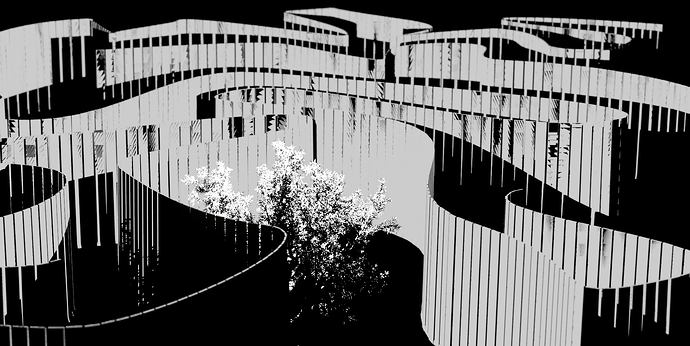I’m designing audioreactive scenes in Blender to use for my liveloop set as an eevee realtime rendering. My issue is that once I start the animation the sample rate drops to around 1 or 2, so the shadows and lights look rather low quality. Shadow box, etc. is already set on higher quality. The main issue is the samples, already with 4-8 it would look much better, but there doessn’t seem to be a way to set it manually. There’s also flickering going on. Maybe some might know a solution. Thanks in advance
Well, Eevee is not designed to be truly realtime. It’s fast enough to get a reasonable approximation of a render in a few seconds, which is enough for most use cases, but that’s not realtime nor is it intended to be.
I am not sure what you are trying to do is even possible (in Eevee), unless maybe you do the render without shadows.
Thanks a lot for your respond! For my last gig I’ve already used EEVEE for one song’s visuals, so it kind of worked. Though roughly on 2 samples. I used shadows, they were a bit grainy but it worked with the denoiser. I was hoping there was a way to improve it.
I was wondering to maybe also use the UPBGE (Blender Game Engine) or some other software for realtime applications. Maybe also Unreal Engine. As I’m most comfortable with Blender designing the scenes. Is there any recommendation about (potentially free) sotware for such realtime purposes? I know of Touchdesigner, but I don’t know if it duits my purposes. I also want to integrate MIDI/OSC control to react to live audio input, which I have already made to work with my Blender set up. It’s basically only the sample issue which is unfortunate for my project as everything else works…Yeah, maybe I’ve to set up scenes with no or very simple shadows
For sure game engines could render a project in realtime, if you know how to use them. If you are going to use one but aren’t intending on making a game, I’m not sure I would recommend Unreal, as it’s really heavy and has a steep learning curve.
The Blender game engine, or any other Blender based game engine (UPBGE, Armory) could likely do it, though I don’t have experience in those and can’t tell how much scripting would be required to make the sound thing work.
I should note though that UPBGE uses Eevee, so I don’t know if you will just have the same problems.
By the way, I assume you have tried deactivating soft shadows in the render settings? If you have to render with low samples, soft shadows would only be a problem, as they require lots of samples to look good.
Thanks again sharing some ideas. Yeah, probably Unreal engine is not the way to go, I’ll be having it run next to Ableton my music software, so I shouldn’t go too heavy with CPU. I’ve tried with & without soft shadows, for my particular project there doesn’t seem to be a difference in performance.
Also I want to adress this flickering and black and white artifacts, really don’t know where they’re coming from. I’m using a solidify modifier to show the outlines, I don’t know if it’s related to that? Here a picture
the plain white wall structures in the foreground are displayed correctly, whereas in the background these black and white artifacts appear
Those artifacts look like they might be related to the “clip start” and “clip end” values. Those values are present both for the viewport (in the right side “n” menu) and for each camera.
If the values have a really wide range, Blender loses accuracy and can’t understand the depth of objects anymore, making triangles appear in the wrong order of depth.
You want the clip start as high as possible without visibly cutting the objects that are near the camera and the clip end as low as possible without cutting the farthest objects.
Amazing, at least one of the issues solved! Thanks a lot!
